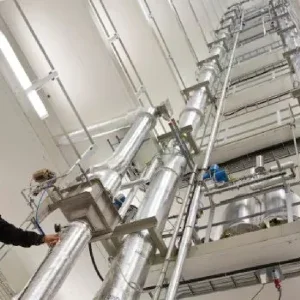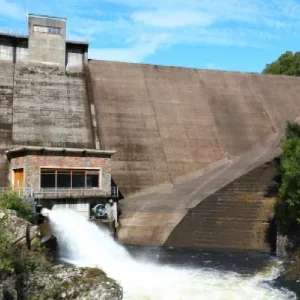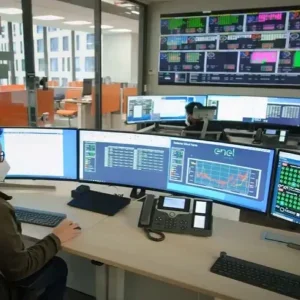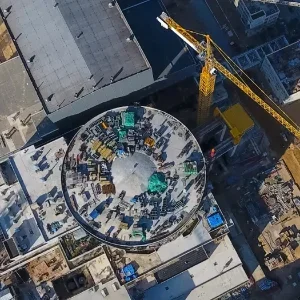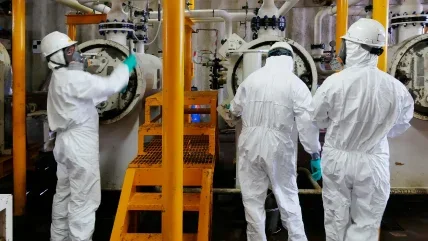
Graphite has been used as a moderator and reflector of neutrons in more than 100 nuclear power reactors and research and plutonium producing reactors. In some reactor designs, it is also used as a fuel sleeving material leading to the generation of large amounts of material that is less irradiated but still requires management. Many of the older reactors are now shut down, with more approaching the end of their lives. Approximately 250,000 tonnes of irradiated graphite have now accumulated worldwide. Increasing amounts of irradiated graphite are being placed in temporary storage facilities pending disposal.
Because of the complexity of how graphite reacts under irradiation (see box) it is evident that no two reactor designs will give rise to irradiated graphite with the exact same set of properties. Different operational histories will affect the radioisotope content as well as the activity of those radioisotopes. Large variations may even arise in the graphite from reactors of a similar type as a result of impurity variations during manufacturing at different facilities.
“Irradiated graphite is a specific type of radioactive waste. Because of the different levels of radiation based on different radiological characteristics – but also differences in chemical, physical characteristics,” Tetiana Kilochytska, Decommissioning Specialist at the International Atomic Energy Agency’s (IAEA’s) Department of Nuclear Energy told NEI. “And all these characteristics affect the disposal route. It depends on many features that are country specific, including the waste management infrastructure available to deal with this type of waste,” she added.
Managing irradiated graphite
Many different approaches for managing irradiated graphite have been, and are being, researched around the world. Although it is generally planned to remove graphite from the majority of reactors as intact blocks, the effects of irradiation, combined with the presence in some cases of metallic components like pins or wires within the structures, means alternative dismantling strategies are also being considered. For example, dismantling of a graphite stack may include methods other than the recovery of intact components. The processing of irradiated graphite material now includes discussions of various possible pathways. For instance, processing may involve partial or complete oxidation of irradiated graphite by incineration or plasma heating or chemically using molten salt oxidation in order to enhance safety during interim storage and near-surface or deep disposal.
There may also be the potential to recover and reutilise certain graphite materials for further use within the nuclear industry; to reduce the waste category of the irradiated graphite for disposal and/or to recover specific isotopes for industrial applications.
“The reason why we are looking for ways to treat irradiated graphite is to reduce the waste classification of bulk graphite by removing radionuclides and conditioning the removed radionuclides into another waste form, explained Willie Meyer, Waste Predisposal Specialist with the Division of Nuclear Fuel Cycle and Waste Technology in the IAEA’s Department of Nuclear Energy. He noted that most of the current irradiated graphite is classed as intermediate-level waste and must be disposed deep underground. “Deep or medium-depth repositories are expensive, and few countries have such facilities… so the aim is to reduce the radioactivity levels in graphite to the low-level waste classification so that it can be disposed of in near surface disposal repositories,” he told NEI.
He explained further that radioactivity in irradiated graphite materials is due to the neutron activation of impurities present in the graphite structure itself with some contribution of air (nitrogen) found in the pore structure that could result in the increased presence of 14C. “Research in the past 10-20 years was aimed at the removal of the outer surface layer of the graphite – to decontaminate graphite by removing leachable radionuclides embedded on surface – without damaging the bulk graphite. In some cases, the resulting material can be re-classified as low-level waste for surface disposal. Recovered 14C and other radionuclides during this process can be reused in the industry, although the market is very small.”
Not all irradiated graphite waste can be surface decontaminated for reclassification as in some cases the contribution of embedded neutron activated impurities inside the graphite structure, and not the activity found on the surface, determines the waste class as intermediate level. For these graphite types, research concentrated on processing to reduce the disposal volume and isolate radionuclides released during these waste processing technologies by, for example, bulk oxidation with incineration or plasma processes using sophisticated ventilation treatment systems. The current dilemma is that graphite itself is an excellent waste form for the embedded neutron activated impurities and so the cost for processing needs to be evaluated against the cost of establishing deep or medium depth repositories for these wastes.
Countries pursue different strategies for the management of graphite wastes from reactor stacks. This ranges from the lengthy ‘care-and-maintenance’ followed by ‘safe-storage’ regimes, as favoured in the UK, the US and Russia, to the immediate dismantling strategies preferred in France and Lithuania. The long-term destiny of such graphite is generally regarded as a deep or medium-depth repository, yet few countries have such facilities. As a result, in many cases available options are temporary or interim storage. Moreover, the depth of disposal impacts waste acceptance criteria, which in turn impacts the waste form, treatment and conditioning methodologies, including package selection and specifications. Kilochytska noted that deferred dismantling was the choice for most graphite reactors because of the need to find appropriate treatment and processing technology to manage the graphite and “the unclear situation on possibilities for its disposal”.
Characterising graphite
Currently, the characterisation of irradiated graphite materials (modelling as well as analytical procedures) to determine the relative position and amount of the radioactivity inside is well established. This information can be used to determine management options, for instance, dismantling, decontamination, processing, or disposal as a waste form. Available dismantling, decontamination and processing methodologies have already been demonstrated successfully. In Spain, for example, the irradiated graphite waste complies with the waste acceptance criteria for their El Cabril facility for disposal. However, in the absence of available deep or medium depth repositories and appropriate processing facilities, some countries have opted for deferred dismantling or safe storage until more information becomes available as there is no ‘single solution’, not least because irradiated graphite waste differs in every country due to different reactor operational histories that affect the radioisotope content, chemical and physical characteristics.
Finding cooperative solutions
Given the extent of the problem posed by irradiated graphite and the complexities involved, the importance of international co-operation cannot be overestimated. The IAEA has paid a great deal of attention to the issue and has encouraged work in this area since 1998. The role of the IAEA is not to prescribe policy on radwaste management but to advise member states of the various options which are being researched, to enable them to make an informed decision on the correct policy for their situation.
In 1999, the IAEA hosted a Technical Meeting, “Nuclear Graphite Waste Management” at the University of Manchester in the UK, the proceedings of which were published in 2001 in the form of a CD-ROM, “Nuclear Graphite Waste Management”. The report resulting from this meeting underwent several reviews and was finally issued in 2006 as a TECDOC, “Characterization, Treatment and Conditioning of Radioactive Graphite from Decommissioning of Nuclear Reactors”.
In 2007, another conference was held in Manchester on “Solutions for Graphite Waste: A Contribution to the Accelerated Decommissioning of Graphite Moderated Nuclear Reactors”. It was organised by the School of Mechanical, Aerospace & Civil Engineering and the Dalton Nuclear Institute of Manchester University in cooperation with the IAEA. While the emphasis was on the problems faced by the UK, the situation in other countries was also presented. The results of the conference were published as an IAEA TECDOC in 2010, “Progress in Radioactive Graphite Waste Management”.
Two separate initiatives also took placed during this period. The US Electric Power Research Institute (EPRI) launched a “Graphite Decommissioning Initiative” which ran from 2006 to 2012 and produced six comprehensive reviews on all aspects of irradiated graphite disposal.
At the same time, Carbowaste, which ran from 2008–2013, was established by the European Union (EU) under the 7th Framework Programme of Euratom. Its aim was to support development of high temperature reactor designs by defining disposal routes for both graphite from moderators and the high carbon content of the particulate fuels, needed for the safety cases to support reactor construction and operation. This programme had 29 participants including South Africa, which was then developing its pebble bed modular reactor.
The IAEA proposed its own initiative to run in parallel with Carbowaste – a Coordinated Research Project (CRP) entitled Treatment of Irradiated Graphite to Meet Acceptance Criteria for Waste Disposal, which ran from 2011 to 2015. This CRP sought to involve a wider spectrum of IAEA member states than were present in Carbowaste. Organisations from 10 countries participated. It was intended:
- To investigate direct chemical or physical treatment of graphite leading to its disposal in an alternative form to solid graphite, with economic and long-term radiological benefits.
- To investigate the pre-treatment of graphite ahead of other disposal or innovative treatment, to reduce the radio-nuclide content and facilitate the economics and radiological safety of the following process operations.
- To research the treatment of the products of innovative process to improve radiological safety or for economic improvement.
In defining these objectives, the IAEA Division of Nuclear Fuel Cycle & Waste Technology noted the apparently diverse and differing criteria for graphite waste disposal applying in different member states and recognised that there is no ‘single solution’ to the graphite disposal problem. In March 2013, the final meeting of Carbowaste participants took place alongside an informal meeting of most participants in the CRP. This was held at the Ignalina NPP training centre in Lithuania. The results of the CRP were published as an IAEA TECDOC in 2016, “Processing of Irradiated Graphite to Meet Acceptance Criteria for Waste Disposal”.
The IAEA then established Project GRAPA (International Project on Irradiated Graphite Processing Approaches), which included representatives from Belgium, China, France, Germany, India, Italy, Republic of Korea, Lithuania, Romania, Russian Federation, Spain, Switzerland, Ukraine and United Kingdom, with direct responsibilities for various parts of the decommissioning and graphite-disposal process in a variety of reactor designs. Interest was also expressed by colleagues from Sweden and Japan. The project ran from 2016 to 2018 but the network has remained in place.
GRAPA dealt with a comprehensive, wide range of characterisation and treatment approaches, Karina Lange, Radioactive Waste Disposal Specialist from the Division of Nuclear Fuel Cycle & Waste Technology at the IAEA’s Department of Nuclear Energy. However, after treatment and conditioning comes disposal “and not many Member States documented their approach to graphite disposal at that time [of GRAPA],” said Kilochytska, adding: “So, the IAEA established a group of Member States with graphite – including France, Russian Federation, UK and USA – as well countries that in the future might include graphite as a moderator in their designs.”
She explained that dealing with smaller amounts is easier. “Spain has shown what to do with smaller amounts by meeting the waste acceptance criteria for the El Cabril facility. This is still being explored in other countries depending on the graphite, the activity, and the volume. Disposal can range from an existing near surface facility all the way to a deep geological repository, and this publication covers that range quite nicely.”
In September 2021, the IAEA, and Electricité de France’s Decommissioning & Waste Management Directorate (EDF DP2D) agreed to work together to help countries to strengthen technology and human resources development for decommissioning graphite reactors. The agreement, valid until 2025, designates EDF-DP2D’s Graphite Reactor Decommissioning Demonstrator as an IAEA Collaborating Centre. The Demonstrator is being constructed near Chinon in central France and will be used to test, improve and optimise innovative robotic and remote handling technologies, physical tests on representative full-scale mock-ups as well as simulators and associated digital models.
These technologies will subsequently be made available to experts from the IAEA member states, Kilochytska said. The IAEA is happy to co-operate with EDF DP2D in using the demonstrator. “It will be a big mock-up facility like a real reactor to develop the dismantling scenarios and techniques and to train the staff who will be involved in dismantling graphite reactors.”
Clearly, the challenges faced in dealing with radioactive graphite and its final disposal are numerous and complex requiring extensive further research and investigation. Ans as Lange says: “When you have all the countries sharing their work, the hope is that by coming together there will be strength in helping each other to take one more step. We promote this kind of international collaboration”. The key to further progress must be to maintain and increase the valuable international co-operation, which is already under way.
Author: Judith Perera
This article first appeared in Nuclear Engineering International magazine.


